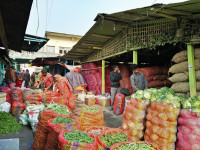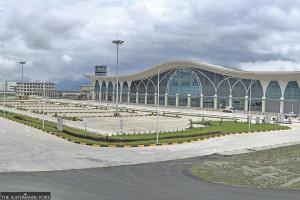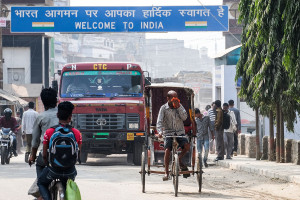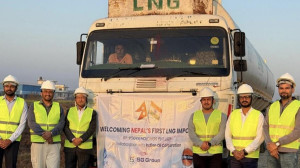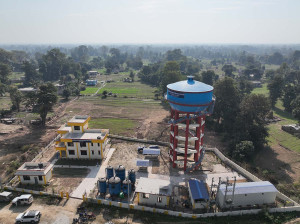Money
Nepal hotels long for tourists spooked by unrest
Tourism industry still reeling from September’s violent Gen Z uprising, with hotels struggling to fill rooms during peak season.
Sangam Prasain
Mandip Giri fondly recalls the autumns when tourists once filled every corner of Thamel. It was the season of clear skies, crowded trekking shops, and packed hotels as travellers prepared to venture into the Himalayan foothills for weeks of adventure.
“Thamel used to bustle in autumn with almost 100 percent occupancy for small and medium-sized hotels,” said Giri, managing director of Dom Himalaya Hotel in Chettrapati, on the western edge of Thamel. “Now, some days we get 30 percent occupancy in our 37-room hotel, some days 40 percent, and if we’re lucky, 50 percent.”
Where once the alleys of Thamel overflowed with visitors, they stand subdued today. The flow of tourists has thinned dramatically since Generation Z—the youth aged between 12 and 28—rose in a sudden revolt against rampant corruption in the country in early September. More than 70 people died while protesters set fire to government offices, leaders’ residences, and businesses.
The violent uprising toppled the government within 24 hours and installed an interim administration with a mandate to hold elections on March 5, 2026—two years ahead of schedule.
The unrest hit Nepal’s tourism industry at the worst possible time—right at the start of the peak season. The World Bank now estimates that the Gen Z uprising will limit Nepal’s economic growth to just 2.1 percent this fiscal year, which ends mid-July 2026.
While the situation has largely stabilised, political tension remains high as the country heads towards the March election.
Still, Giri is hopeful that normalcy, and tourists, will return soon.
In Chitwan’s Sauraha, a popular jungle safari destination, the impact has been equally severe. This is usually the time when domestic tourists crowd the area taking advantage of the Dashain and Tihar holidays, while foreigners visit for jeep safaris and glimpses of rhinos, elephants, and tigers in the famed Chitwan National Park.
“With business sharply declining from early September to early October, we’re finally seeing signs of revival because tourists have started coming back,” said Suman Ghimire, executive director of Jungle Safari Lodge. “It’s much better now. Two weeks ago, we had almost zero guests. Now, we’re getting visitors again.”
“Right now, it’s just about survival,” he added. “There’s no profit.”
In Chitwan, hotel occupancy was around 40 percent in September but has climbed to 50 percent by mid-October. “We’re hoping to reach 60 percent in November,” said Ghimire. “The protest led to massive cancellations for October and November, and at one point, we thought everything had collapsed. But as things stabilise, bookings are returning.”
Tourism entrepreneurs, however, remain cautious. Another political event looms on the horizon—the March election—which coincides with the spring trekking season, Nepal’s other tourism peak.
Across major cities, hotels continue to struggle, with average occupancy hovering around one-third despite it being the busiest period of the year.
“Most hotels are struggling except for a few,” said Binayak Shah, president of Hotel Association Nepal, which represents more than 300 hotels and resorts. “Most cancellations have come from India, Nepal’s top source market.”
Shah said that while the number of budget travellers has remained steady, high-spending tourists are staying away. “Agencies sending such travellers are in a ‘wait and see’ mode because of the travel advisories issued by several countries,” he said.
To counter the downturn, the Nepal Tourism Board has relaunched its once-successful digital campaigns—#NowInNepal, #NepalNow, and WE ARE IN NEPAL NOW—which were first used after the 2015 earthquakes and during the Covid pandemic.
The campaigns feature foreigners currently in Nepal sharing photos holding placards with the hashtags, reassuring potential visitors that the country is safe.
The board has also begun livestreaming major tourist areas in Kathmandu Valley to convince international partners that Nepal is calm and secure.
Last week, Prime Minister Sushila Karki briefed Nepali ambassadors abroad, instructing them to actively promote tourism revival.
“The tourism sector has suffered a significant hit following the Gen Z movement,” Karki said. “In this peak month of October, hotel bookings are only around 30 percent, when they should be near 70 percent. You must inform all parties that the situation has normalised and that tourism, trade, and investment have resumed as before. It’s also important to highlight that foreign tourists were never targeted during the protests—in fact, many were helped. This reflects our culture of Atithi Devo Bhava [the guest is god], even in times of crisis.”
Convincing visitors, however, remains a challenge. “News is spreading that jailbreakers are roaming freely and hundreds of police weapons are missing,” said Shah. “That kind of news terrifies tourists. We have to work together to rebuild confidence that Nepal is safe.”
In September, traditionally the key month for trekking and mountaineering, tourist arrivals fell by 18 percent following the unrest.
Yet some signs of recovery are emerging. Intrepid Travel Nepal, the representative office of the Australia-based adventure travel company Intrepid Travel—the world’s largest in the sector—reported only a small number of cancellations.
“We’ve had about 60 individual cancellations until December, but no group trips have been cancelled,” said Yalamber Rai, country general manager of Intrepid Travel Nepal. “In October alone, we have around 700 bookings, which is quite good under the circumstances. Things are rebounding quickly.”
In 2024, Intrepid brought more than 3,500 travellers to Nepal. “The outlook for 2026 looks promising,” Rai added. “We are optimistic.”
For Nepal, however, the stakes are high. The country is still struggling to regain momentum after a series of crises—the decade-long Maoist insurgency (1996–2006), the 2001 royal massacre, the 2015 earthquake, and the Covid pandemic. Tourism has long been seen as a lifeline for its fragile economy.
But persistent political instability, rampant corruption, and policy inconsistency continue to trap Nepal in a cycle of slow growth, undermining efforts to build a resilient tourism industry.
Last fiscal year, nearly a million Nepalis left the country for jobs or education abroad, underscoring the lack of opportunities at home.
Nepal welcomed 1.14 million foreign visitors last year, a 13 percent increase from 2023, though still below the pre-pandemic high of 1.2 million. In the first nine months of this year, 815,273 tourists arrived, suggesting a steady recovery—until the protests struck in September, halting momentum and leaving hotels, guides, and trekking agencies scrambling.
According to the World Travel and Tourism Council, tourism contributed Rs327.9 billion ($2.5 billion) to Nepal’s economy in 2023, supporting 1.19 million jobs directly and indirectly.
Now, with confidence shaken once again, the industry waits—hoping that calm and clarity will return before another crucial travel season slips away.




 18.12°C Kathmandu
18.12°C Kathmandu
